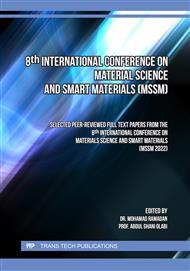p.3
p.11
p.19
p.25
p.35
p.45
p.55
p.65
Coating Glass Fibre Yarn with Conductive Materials for Real-Time Structure Sensing
Abstract:
Nowadays, the demand for glass fibre-reinforced polymers (GFRPs) has increased in the industry owing to their low weight, high strength, corrosion resistance and low cost compared with other fibre-reinforced polymer composites. However, GFRP is anisotropic material with low interlaminar strength where the damage can occur without warning. Integrating a real-time damage detection process can mitigate this problem. Therefore, this paper presents the initial fabrication of an embedded capacitive sensor into the GFRP by using conductive electrodes inbetween its layers. To form the sensing electrodes, glass fibre yarns were coated with conductive material and braided into the fibregalss woven fabric. Two coating methods were considered to form embedded electrodes in this work which include aerosol spray coatings that were carbon based and gold-based physical vapour deposition, (PVD). It has been shown that spray coating has a weak bond and the carbon particles disperse during the molding process. In the PVD technique the nanoparticle (Au) distributed uniformly along the fibres and has a good resistance (≈100Ω). The capacitive sensor based on gold coating was exaimined using a three point bending test which demonstrate linear response toward the flexural load with a sensitivity of 25.1 fF/N.
Info:
Periodical:
Pages:
25-32
Citation:
Online since:
October 2023
Price:
Сopyright:
© 2023 Trans Tech Publications Ltd. All Rights Reserved
Share:
Citation:



